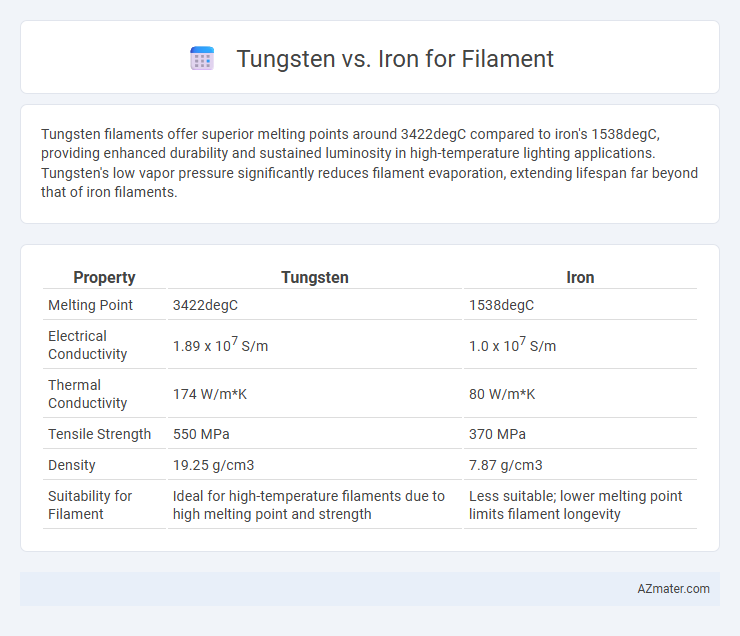Tungsten filaments offer superior melting points around 3422degC compared to iron's 1538degC, providing enhanced durability and sustained luminosity in high-temperature lighting applications. Tungsten's low vapor pressure significantly reduces filament evaporation, extending lifespan far beyond that of iron filaments.
Table of Comparison
| Property | Tungsten | Iron |
|---|---|---|
| Melting Point | 3422degC | 1538degC |
| Electrical Conductivity | 1.89 x 107 S/m | 1.0 x 107 S/m |
| Thermal Conductivity | 174 W/m*K | 80 W/m*K |
| Tensile Strength | 550 MPa | 370 MPa |
| Density | 19.25 g/cm3 | 7.87 g/cm3 |
| Suitability for Filament | Ideal for high-temperature filaments due to high melting point and strength | Less suitable; lower melting point limits filament longevity |
Introduction to Filament Materials
Filament materials in incandescent bulbs require high melting points and durability to withstand extreme temperatures during operation. Tungsten, with a melting point of 3422degC and excellent tensile strength, surpasses iron, which melts at 1538degC and oxidizes rapidly when heated. The superior thermal stability and longevity of tungsten make it the preferred choice for filament manufacturing in lighting applications.
Historical Use of Tungsten and Iron in Filaments
Tungsten has been the preferred material for filaments since the early 20th century due to its high melting point of 3,422degC and excellent durability, which significantly outperformed iron, used in earlier incandescent bulbs. Iron filaments, while initially popular in the late 19th century for their availability and low cost, suffered from rapid oxidation and low melting points, limiting their practical lifespan. The shift to tungsten revolutionized filament technology by enabling longer-lasting, higher-efficiency light bulbs, making tungsten the industry standard.
Physical Properties Comparison: Tungsten vs Iron
Tungsten exhibits a melting point of 3422degC, significantly higher than iron's 1538degC, making it ideal for filament applications requiring extreme heat resistance. Its tensile strength reaches up to 1510 MPa, surpassing iron's 370 MPa, providing superior durability and longevity. Additionally, tungsten's lower thermal expansion coefficient (4.5x10^-6/K) compared to iron (11.8x10^-6/K) ensures greater dimensional stability under high temperatures.
Thermal Conductivity and Melting Points
Tungsten outperforms iron as a filament material due to its high melting point of 3422degC, compared to iron's lower melting point of 1538degC, enabling tungsten to withstand extreme temperatures without melting. Tungsten's thermal conductivity is approximately 174 W/m*K, which is lower than iron's 80 W/m*K but sufficiently high to dissipate heat efficiently, preventing filament burnout. The combination of tungsten's superior melting point and adequate thermal conductivity makes it ideal for high-temperature filament applications such as incandescent light bulbs.
Electrical Resistance and Efficiency
Tungsten exhibits significantly higher electrical resistance compared to iron, which allows it to generate more heat at lower currents, making it ideal for filament use. Its superior efficiency stems from a high melting point of 3422degC, enabling longer lifespan and stable light output under intense electrical stress. In contrast, iron's lower resistance and melting point reduce its efficiency and durability in filament applications.
Durability and Lifespan Analysis
Tungsten filaments exhibit superior durability compared to iron due to their higher melting point of 3422degC and excellent resistance to oxidation at elevated temperatures. Iron filaments, with a melting point of 1538degC, degrade more rapidly under similar operating conditions, leading to shorter lifespan in incandescent bulbs. The longer lifespan of tungsten filaments results from their ability to maintain structural integrity and resist evaporation during prolonged heat exposure.
Cost and Availability Considerations
Tungsten filaments offer superior heat resistance and longevity but come at a significantly higher cost due to the metal's rarity and complex manufacturing processes. Iron filaments are more affordable and widely available, yet they lack the durability and efficiency of tungsten, leading to shorter lifespans. Industries often weigh tungsten's premium price against its performance benefits, while iron remains a cost-effective choice for lower-end applications.
Performance in Lighting Applications
Tungsten outperforms iron as a filament material in lighting due to its exceptionally high melting point of 3422degC, enabling it to operate at higher temperatures and produce brighter, more efficient light. Its superior tensile strength and resistance to evaporation under high heat extend the filament's lifespan significantly compared to iron. Tungsten's thermal and electrical properties optimize energy conversion into visible light, making it the preferred choice for incandescent bulbs and high-performance lighting applications.
Environmental Impact and Safety
Tungsten filaments offer superior durability and higher melting points compared to iron, reducing the frequency of replacements and waste generation, which minimizes environmental impact. Iron, while cheaper, oxidizes quickly and requires coatings or replacements more often, leading to increased resource consumption and potential environmental hazards. Tungsten's non-toxic properties and lower oxidation rate enhance safety during use, whereas iron's rusting can produce harmful particles and corrosion-related risks.
Conclusion: Choosing the Optimal Filament Material
Tungsten remains the optimal filament material due to its exceptionally high melting point of 3422degC and superior durability, enabling longer filament life and consistent light output. Iron, though more affordable, has a lower melting point around 1538degC, resulting in quicker oxidation and reduced filament lifespan under high operating temperatures. Selecting tungsten ensures enhanced energy efficiency and longevity, crucial for reliable incandescent lamp performance.

Infographic: Tungsten vs Iron for Filament
 azmater.com
azmater.com